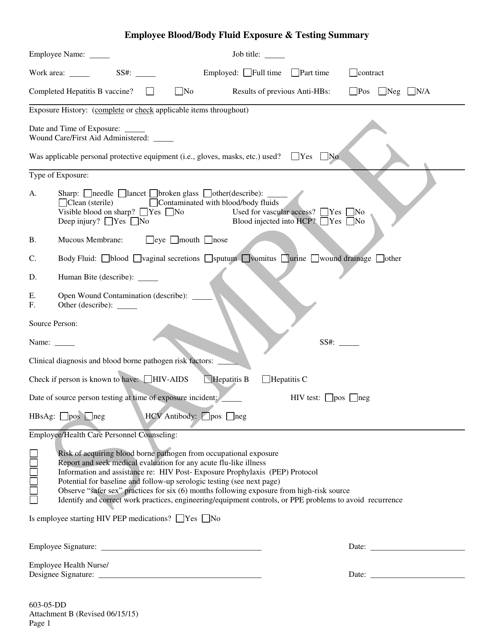Attachment B Employee Blood / Body Fluid Exposure & Testing Summary - Sample - South Carolina
What Is Attachment B?
This is a legal form that was released by the South Carolina Department of Disabilities and Special Needs - a government authority operating within South Carolina. As of today, no separate filing guidelines for the form are provided by the issuing department.
FAQ
Q: What is the purpose of the Employee Blood/Body Fluid Exposure & Testing Summary?
A: The purpose of the Employee Blood/Body Fluid Exposure & Testing Summary is to document and track incidents of blood or body fluid exposure in the workplace, as well as the testing and follow-up procedures for affected employees.
Q: Why is it important to document and track incidents of blood or body fluid exposure in the workplace?
A: Documenting and tracking incidents of blood or body fluid exposure in the workplace is important for ensuring the safety of employees and identifying potential health risks. It also helps in implementing appropriate preventive measures and providing necessary medical care.
Q: What information is included in the Employee Blood/Body Fluid Exposure & Testing Summary?
A: The Employee Blood/Body Fluid Exposure & Testing Summary includes details about the incident, such as the date, time, location, and circumstances of the exposure. It also records the type of fluid involved, procedures performed, and any testing or medical treatment given to the employee.
Q: Who is responsible for completing the Employee Blood/Body Fluid Exposure & Testing Summary?
A: The responsibility for completing the Employee Blood/Body Fluid Exposure & Testing Summary lies with the employee who experienced the exposure, their supervisor, and the occupational health department or designated individual responsible for managing workplace exposures.
Q: What should employees do if they experience a blood or body fluid exposure?
A: If employees experience a blood or body fluid exposure, they should immediately wash the affected area with soap and water, inform their supervisor, and seek medical evaluation. They should also complete the Employee Blood/Body Fluid Exposure & Testing Summary and follow any recommended testing or follow-up procedures.
Q: Are employees required to undergo testing after a blood or body fluid exposure?
A: Yes, employees who have a blood or body fluid exposure should undergo testing as recommended by healthcare professionals. Testing helps determine if there is any risk of infection and allows for appropriate preventive and treatment measures to be taken.
Q: Is there a need for ongoing monitoring after a blood or body fluid exposure?
A: Yes, ongoing monitoring may be necessary after a blood or body fluid exposure, depending on the circumstances. This helps ensure the health and well-being of the affected employee and allows for timely intervention if any health issues arise.
Q: What measures are taken to prevent blood or body fluid exposure in the workplace?
A: To prevent blood or body fluid exposure in the workplace, employers implement measures such as providing personal protective equipment (PPE), offering training on infection control and safe work practices, conducting regular workplace assessments, and promoting a culture of safety.
Q: What are the potential health risks associated with blood or body fluid exposure?
A: Potential health risks associated with blood or body fluid exposure include the transmission of bloodborne pathogens, such as HIV, hepatitis B, and hepatitis C. These pathogens can lead to serious infections and long-term health consequences if not properly managed.
Q: Is confidentiality maintained for employees who experience blood or body fluid exposure?
A: Yes, confidentiality is maintained for employees who experience blood or body fluid exposure. Their personal health information is protected in accordance with privacy laws and regulations.
Form Details:
- Released on June 15, 2015;
- The latest edition provided by the South Carolina Department of Disabilities and Special Needs;
- Easy to use and ready to print;
- Quick to customize;
- Compatible with most PDF-viewing applications;
- Fill out the form in our online filing application.
Download a printable version of Attachment B by clicking the link below or browse more documents and templates provided by the South Carolina Department of Disabilities and Special Needs.





